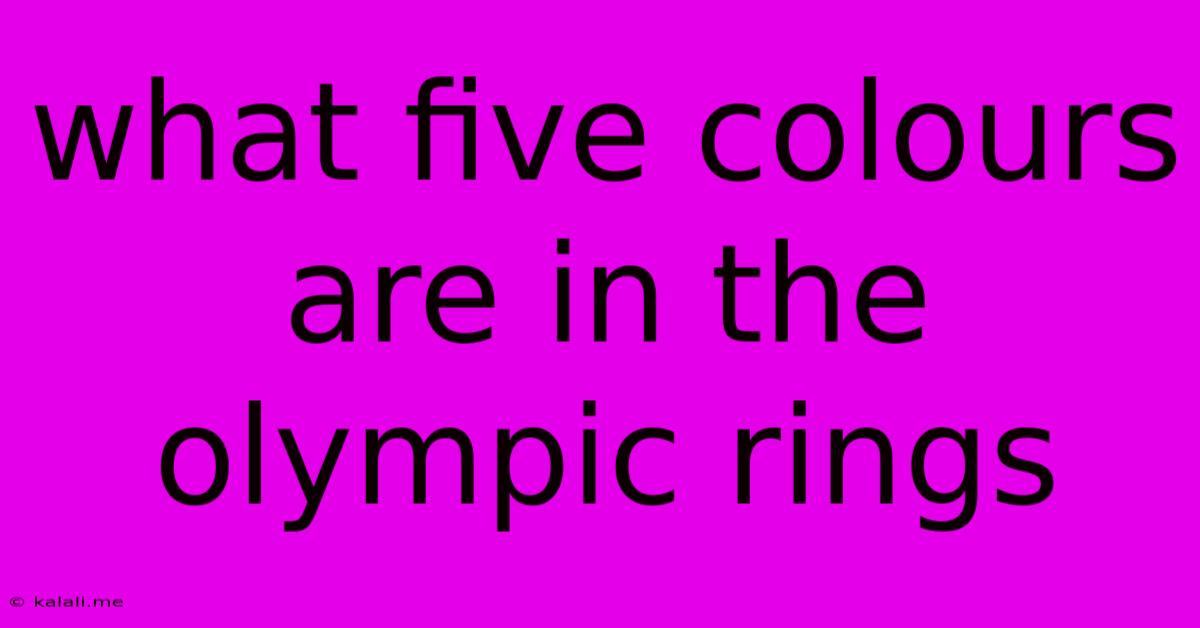What Five Colours Are In The Olympic Rings
Kalali
Jun 12, 2025 · 3 min read

Table of Contents
What Five Colors Are in the Olympic Rings? A Colorful History
The Olympic rings are instantly recognizable worldwide, a symbol of unity and athletic competition. But do you know the specific colors of these iconic rings? This article delves into the five colors of the Olympic rings, their symbolism, and their history. Understanding this simple yet powerful visual representation is key to appreciating the Olympic Games' broader message.
The five colors in the Olympic rings are blue, yellow, black, green, and red. These aren't just randomly chosen hues; they represent the continents of the world and are designed to ensure that at least one color is present in the flag of every participating nation. This clever design fosters a sense of global inclusion and participation.
The Symbolism Behind the Colors
While there's no official meaning assigned to each color's specific continent, the presence of all five colors is symbolic of global unity. The Olympic rings themselves represent the five inhabited continents (Africa, Asia, America, Europe, and Oceania), and the interconnectedness of the rings emphasizes the interconnectedness of nations.
Here's a breakdown of each color:
- Blue: Often associated with the continent of Europe. Blue represents peace, harmony, and tranquility.
- Yellow: Frequently linked to Asia. Yellow signifies optimism, joy, and energy.
- Black: Commonly representing Africa. Black stands for strength, power, and resilience.
- Green: Often associated with Oceania. Green embodies nature, growth, and renewal.
- Red: Frequently connected to the Americas. Red symbolizes courage, passion, and determination.
The History of the Olympic Rings
The design of the five interlocking rings was created by Baron Pierre de Coubertin, the founder of the modern Olympic Games. He unveiled the design in 1913, choosing these five colors to ensure representation of all nations. The rings are not only visually striking but also a powerful symbol of the games themselves. The interlocking design emphasizes the interconnectedness and cooperation of athletes from different countries coming together in friendly competition.
The Olympic rings, with their vibrant colors and powerful symbolism, remain one of the most widely recognized symbols in the world. Their enduring appeal lies in their simple yet profound message of global unity and the spirit of athletic competition. Understanding the five colors and their historical context enhances our appreciation for the rich legacy of the Olympic Games and its commitment to global participation.
Beyond the Colors: The Complete Olympic Symbol
While the colors are significant, the overall design of the interlocking rings is equally crucial. The interconnectedness of the rings represents the unity and harmony of the global community through sport. It transcends national boundaries, promoting international understanding and collaboration. The simple yet effective design has proven remarkably enduring, maintaining its iconic status for over a century.
The next time you see the Olympic rings, remember the significance of their five colors – blue, yellow, black, green, and red – and the powerful message of global unity they represent. They aren’t just pretty colors; they’re a symbol of the world coming together through the spirit of sport.
Latest Posts
Latest Posts
-
What Does Yellow Clock Mean In Outlook
Jun 13, 2025
-
What Is The Opposite Of Artificial
Jun 13, 2025
-
What Is The Gravitational Force Acting On An Object
Jun 13, 2025
-
Which Electromagnetic Has The Longest Wavelength
Jun 13, 2025
-
What Was Vellum Originally Made From
Jun 13, 2025
Related Post
Thank you for visiting our website which covers about What Five Colours Are In The Olympic Rings . We hope the information provided has been useful to you. Feel free to contact us if you have any questions or need further assistance. See you next time and don't miss to bookmark.